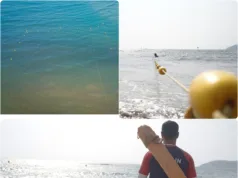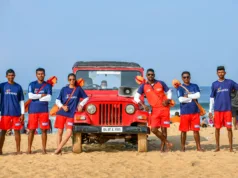With the Indian Meteorological Department (IMD) predicting soaring temperatures this summer, Drishti Marine, the state-appointed professional lifeguard agency, has issued a summer advisory suggesting simple ways to stay safe while at the beach on a hot, sunny day.
In light of the prediction which hints at temperatures ranging from 33 degrees Celsius to 35 degrees Celsius for the next seven days across the state, the Goa State Disaster Management Authority also recently issued a public notice titled ‘Preventive Measures on Heatwave’ that outlines precautions one should adhere to during this extreme weather period.
The advisories by Drishti Marine and the state authorities come at a time when tourists, primarily domestic travellers, have been heading to Goa, with families in tow, for their annual summer break.
Owing to the present sea conditions, it is advisable to swim between the flags marked in red and yellow, as they indicate moderate surf and currents, while strictly avoiding the red flag areas, which indicate non-swim zones.
A beach umbrella is ideal for shielding yourself from direct heat and staying hydrated by drinking plenty of water. It’s advisable to carry sunscreen to prevent sunburns and heat strokes. While the inviting blue sea offers relief during sweltering summers, beachgoers should be cautious of rip currents, flash currents and underwater currents before taking a dip. Lifesavers stationed along the coast are trained to conduct rescues in rough sea conditions. Drishti Marine’s 450-strong lifesaving force mans Goa’s beaches throughout the year.
According to Navin Awasthi, chief executive officer at Drishti Marine, “The scorching heat can cause skin rashes, sunburns and heat strokes. Make sure to stay hydrated throughout the day and try to avoid being in direct sunlight between noon and 3 pm when the rays are the harshest.”
“There are 35 lifesaver towers spread across Goa. In case of any injury, it is best for the beachgoers to approach a lifesaver for help, as each lifesaver tower is equipped with a first-aid kit,” Awasthi adds.
Each morning, lifesavers map the sea currents, changes in wind patterns and underwater activity in order to identify safe swim zones along every beach and mark them with the red and yellow flags. Unsafe zones that are at risk of underwater and rip currents are marked by red flags, indicating that it is unsafe to swim.
DO’S & DON’TS FOR THE SUMMER:
• Always swim in the safe swim zones, as marked by Drishti Marine lifesavers. While on the beach, find the red and yellow flags and always swim between them. Do not venture into the no-swim zones marked with red flags.
• Whenever possible, always swim in proximity to lifesaver towers and lifesavers. There are 22 beaches across South Goa and 17 beaches across the North Goa stretch that are under the watchful eye of the lifesavers. Additionally, Drishti Marine lifesavers are posted at Mayem lake and Dudhsagar waterfalls too.
• It is best to visit the beach when the lifesavers are on duty between 7:30 am and 6 pm.
• It is advisable to carry caps, umbrellas, sunscreen and a water bottle to beat dehydration, sunburns and heat-strokes.
• Keep yourself hydrated by drinking plenty of water.
• If a child goes missing, do not panic. Alert a lifesaver immediately.
• If you encounter a rip current while swimming, it is safest to stay afloat and alert the lifesaver on duty. Lifesavers are constantly monitoring the beach and are trained to identify swimmers in distress.
• Never swim alone. If you get into trouble, stick your hand in the air and shout for help.
• Always read and obey the safety signs usually found at the main entrance of the beach.
• Do not attempt to rescue if you see anyone in difficulty, if you are not a trained lifesaver. Instead, contact the nearest lifesaver or approach the lifesaving tower for assistance.







